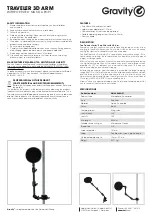
2-5
Brooks
®
Digital MFC's & MFM's
Section 2 Installation
Installation and Operation Manual
X-TMF-SLA5800-Series-RevB-MFC-eng
Part Number: 541B187AAG
January, 2017
The main point is to not instantly open a ball valve and allow a high upstream
pressure or high back pressure surge into the SLA5853 main valve.
Proper process line venting is also important. If operating at pressures
greater than 50 psig, be sure to perform a controlled pressure release from
inlet and back pressure simultaneously in order to prevent bellows damage
from excesssive back pressure.
Following careful startup and venting procedures will contribute to a long
problem free life of your SLA5853 controller.
Stable Operating Conditions:
As stated above, the SLA5853
model utilizes a pressure operated main valve.
Valve performance is dependant on stable system pressures. Oscillating or
unstable upstream or downstream pressures are likely to cause the device
flow control to become unstable. For the best performance, it is important to
create a stable pressure environment by utilizing quality inlet and back
pressure regulators in your process design. In many cases, the addition of a
back pressure regulator will isolate the SLA5853 from the unstable
downstream pressures inherent in many process designs.
All thermal mass flow controllers are factory tested with stable and equal
ambient and process temperatures. If the process temperature does not
equal the ambient temperature, the bypass ratio/accuracy will be affected.
When a hot or cold process fluid is being measured, ensure that the piping
system is designed to allow the gas temperature to equalize with the flow
controller ambient temperature.
For more information, please contact the Brooks Technical Service group.
2-10
Electrical Interface
The setpoint signal is supplied as a 0(1) to 5 Vdc, 0 to 10 Vdc or 0(4)-20 mA
analog signal. All signals are supplied via the 15-pin D-Connector. For an
analog unit the minimum set of connections which must be made to the MFC
and MFM in13.5 - 27 Vdc, supply common, and a setpoint signal.
The Brooks Digital electrical interface is designed to facilitate
low-loss, quiet signal connections. Separate returns (commons) are
supplied for the analog setpoint, analog flow signal, and the power supply.
These commons are electrically connected together on the PC board.
Analog I/O Versions
• Signal Common
• Signal Output (Voltage or Current)
• +13.5 - 27 Vdc Supply
• Setpoint Input (Voltage or Current)
• Setpoint Common
• Supply Common
• Chassis Ground (via unit body)
Refer to Figures 2-1, 2-2, 2-3, 2-4 and 2-5 for pin connections and
electrical I/O connections.
(The Brook’s MFC acts as a current sink to a setpoint input signal. The 0/4-20 mA
setpoint signal should be “driven” into the MFC input by a controlled current source.
Reference Brook’s device specifications for the setpoint input impedance.)
(The Brook’s MFC acts as the current source when providing a 0/4-20 mA output
signal to the load. The output signal is “driven” by the MFC into the customer
load. Reference Brook’s device specifications for maximum load capacity.)
















































